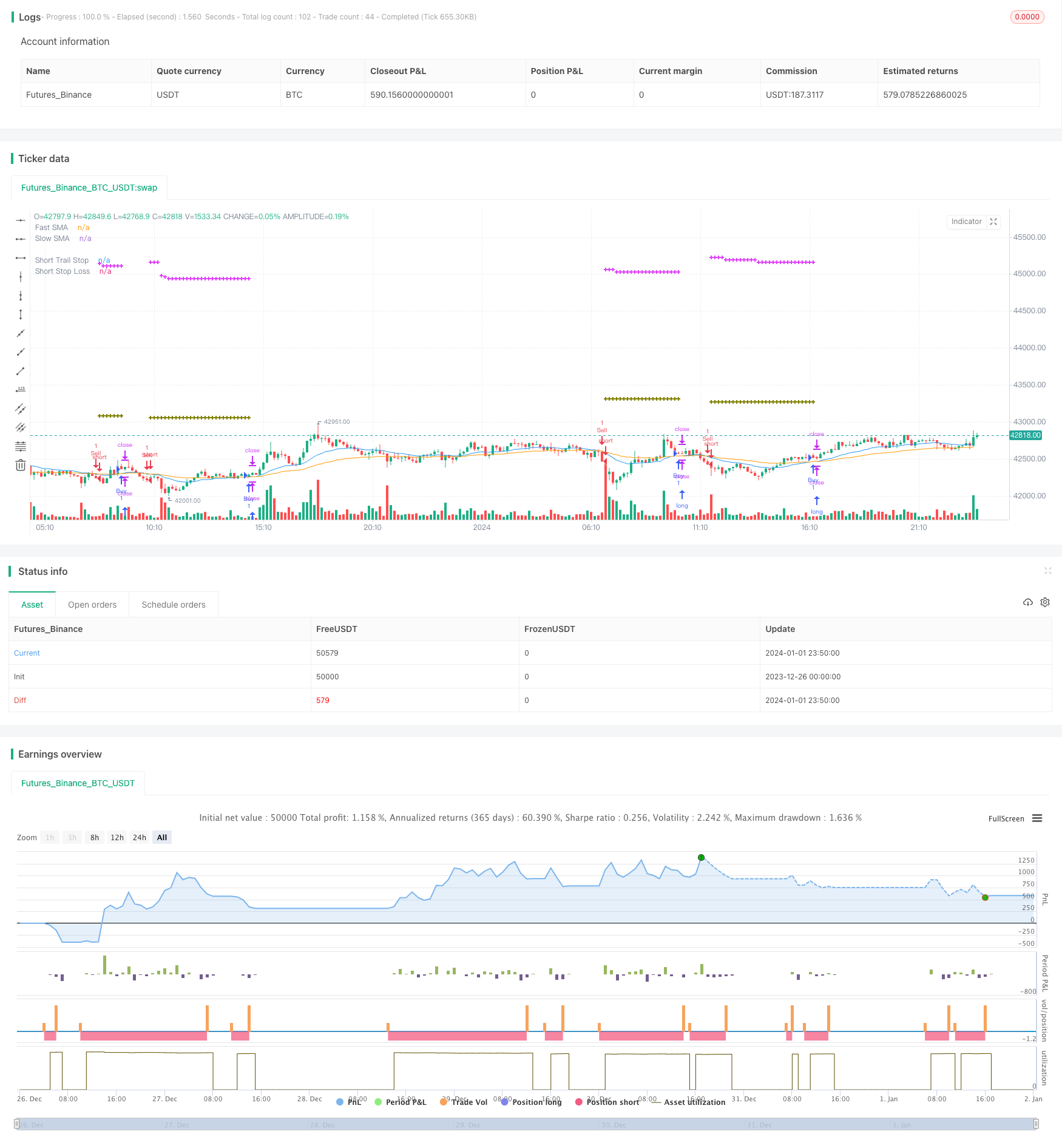
概述
本策略的核心是将指数平滑移动平均线作为买卖信号,结合尾随止损和百分比止损来锁定利润并控制风险。策略简单可实施,适用于股票及其他金融产品的量化交易。
策略原理
计算快速EMA和慢速EMA,快速EMA周期为20天,慢速EMA周期为50天。当快速EMA上穿慢速EMA时生成买入信号;当快速EMA下穿慢速EMA时生成卖出信号。
入场后设置尾随止损,根据持仓方向分别设置多仓尾随止损和空仓尾随止损的百分比,例如7%。尾随止损会每根K线自动调整,锁定最大可能利润。
同时设置止损位置,根据持仓方向和入场价分别设置多仓止损价和空仓止损价的百分比,例如2%。止损位置固定不变,防止过大损失。
比较尾随止损价和止损价,选择更靠近市价的那个为本笔交易的止损位置,发出止损单。
策略优势
移动平均信号简单易懂,容易实施。
尾随止损能最大限度锁定利润,同时防止误判带来不必要的损失。
百分比止损直观易调整,可以控制每笔交易的最大损失。
结合尾随止损和固定止损,既锁定利润,也控制风险。
风险及对策
移动平均策略容易产生假信号,引入urther强过滤条件。
尾随止损有时会过早止损,适当放宽止损幅度。
固定止损位置设置不当可能过于激进或保守,需测试调整百分比参数。
机械地止损可能错过市场反转机会,可以结合技术指标判断止损。
优化思路
尝试不同参数的EMA组合,寻找最佳平衡。
加入成交量等指标过滤假信号。
测试更多股票找到适合的止损参数。
尝试加入移动止损,根据市场调整止损位置。
结合RSI等指标判断止损时机。
总结
该策略整合了移动平均交易信号、尾随止损和百分比止损,通过参数优化,能够适用于多种股票和商品,取得稳定收益的同时严格控制风险,值得量化交易者研究实践并不断优化。
策略源码
/*backtest
start: 2023-12-26 00:00:00
end: 2024-01-02 00:00:00
period: 10m
basePeriod: 1m
exchanges: [{"eid":"Futures_Binance","currency":"BTC_USDT"}]
*/
// This source code is subject to the terms of the Mozilla Public License 2.0 at https://mozilla.org/MPL/2.0/
// © wouterpruym1828
//@version=5
strategy(title=" Combining Trailing Stop and Stop loss (% of instrument price)",
overlay=true, pyramiding=1, shorttitle="TSL&SL%")
//INDICATOR SECTION
// Indicator Input options+
i_FastEMA = input.int(title = "Fast EMA period", minval = 0, defval = 20)
i_SlowEMA = input.int(title = "Slow EMA period", minval = 0, defval = 50)
// Calculate moving averages
fastEMA = ta.ema(close, i_FastEMA)
slowEMA = ta.ema(close, i_SlowEMA)
// Plot moving averages
plot(fastEMA, title="Fast SMA", color=color.blue)
plot(slowEMA, title="Slow SMA", color=color.orange)
//STRATEGY SECTION
// Calculate trading conditions
buy = ta.crossover(fastEMA, slowEMA)
sell = ta.crossunder(fastEMA, slowEMA)
// STEP 1:
// Configure trail stop loss level with input options (optional)
longTrailPerc = input.float(title="Long Trailing Stop (%)", minval=0.0, step=0.1, defval=7) * 0.01
shortTrailPerc = input.float(title="Short Trailing Stop (%)", minval=0.0, step=0.1, defval=7) * 0.01
//Configure stop loss level with input options (optional)
longStopPerc = input.float(title="Long Stop Loss (%)", minval=0.0, step=0.1, defval=2)*0.01
shortStopPerc = input.float(title="Short Stop Loss (%)", minval=0.0, step=0.1, defval=2)*0.01
// STEP 2:
// Determine trail stop loss prices
longTrailPrice = 0.0, shortTrailPrice = 0.0
longTrailPrice := if (strategy.position_size > 0)
stopValue = high * (1 - longTrailPerc)
math.max(stopValue, longTrailPrice[1])
else
0
shortTrailPrice := if (strategy.position_size < 0)
stopValue = low * (1 + shortTrailPerc)
math.min(stopValue, shortTrailPrice[1])
else
999999
// Determine stop loss prices
entryPrice = 0.0
entryPrice := strategy.opentrades.entry_price(strategy.opentrades - 1)
longLossPrice = entryPrice * (1 - longStopPerc)
shortLossPrice = entryPrice * (1 + shortStopPerc)
// Plot stop loss values for confirmation
plot(series=(strategy.position_size > 0) ? longTrailPrice : na,
color=color.fuchsia, style=plot.style_cross,
linewidth=2, title="Long Trail Stop")
plot(series=(strategy.position_size < 0) ? shortTrailPrice : na,
color=color.fuchsia, style=plot.style_cross,
linewidth=2, title="Short Trail Stop")
plot(series=(strategy.position_size > 0) ? longLossPrice : na,
color=color.olive, style=plot.style_cross,
linewidth=2, title="Long Stop Loss")
plot(series=(strategy.position_size < 0) ? shortLossPrice : na,
color=color.olive, style=plot.style_cross,
linewidth=2, title="Short Stop Loss")
// Submit entry orders
if (buy)
strategy.entry("Buy", strategy.long)
if (sell)
strategy.entry("Sell", strategy.short)
//Evaluating trailing stop or stop loss to use
longStopPrice = longTrailPrice < longLossPrice ? longLossPrice : longTrailPrice
shortStopPrice = shortTrailPrice > shortLossPrice ? shortLossPrice : shortTrailPrice
// STEP 3:
// Submit exit orders for stop price
if (strategy.position_size > 0)
strategy.exit(id="Buy Stop", stop=longStopPrice)
if (strategy.position_size < 0)
strategy.exit(id="Sell Stop", stop=shortStopPrice)